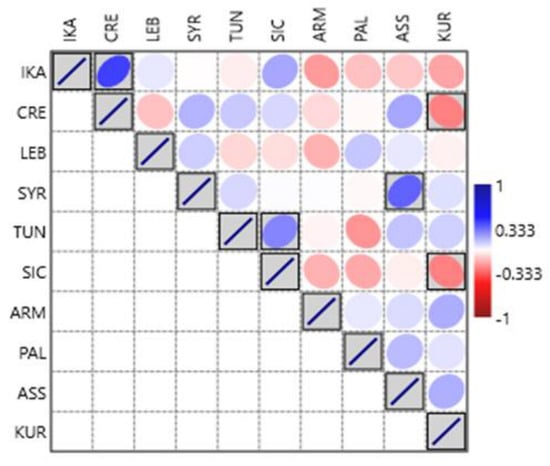Abstract
The current study reports an ethnobotanical field investigation of traditionally gathered and consumed wild greens (Chorta) in one of the five so-called Blue Zones in the world: Ikaria Isle, Greece. Through 31 semi-structured interviews, a total of 56 wild green plants were documented along with their culinary uses, linguistic labels, and locally perceived tastes. Most of the gathered greens were described as bitter and associated with members of Asteraceae and Brassicaceae botanical families (31%), while among the top-quoted wild greens, species belonging to these two plant families accounted for 50% of the wild vegetables, which were consumed mostly cooked. Cross-cultural comparison with foraging in other areas of the central-eastern Mediterranean and the Near East demonstrated a remarkable overlapping of Ikarian greens with Cretan and Sicilian, as well as in the prevalence of bitter-tasting botanical genera. Important differences with other wild greens-related food heritage were found, most notably with the Armenian and Kurdish ones, which do not commonly feature many bitter greens. The proven role of extra-oral bitter taste receptors in the modulation of gastric emptying, glucose absorption and crosstalk with microbiota opens new ways of looking at these differences, in particular with regard to possible health implications. The present study is also an important attempt to preserve and document the bio-cultural gastronomic heritage of Chorta as a quintessential part of the Mediterranean diet. The study recommends that nutritionists, food scientists, and historians, as well as policymakers and practitioners, pay the required attention to traditional rural dietary systems as models of sustainable health.
1. Introduction
The Mediterranean diet (MD)—a nutritional model derived from the cross-cultural epidemiological seven countries study by the American nutritionist Ancel Benjamin Keys [1]—has been attributed to the “food patterns typical of Greece and southern Italy in the early 1960s, where adult life expectancy was among the highest in the world and rates of coronary heart disease, certain cancers, and other diet-related chronic diseases were among the lowest” [2,3,4,5,6]. The MD was recognized as an intangible cultural heritage of humanity by UNESCO a decade ago [7,8]. This food system has been the subject of extensive biomedical literature with important outcomes for public health. The main health benefits of the MD can be resumed in some major effects known to be involved in the origin of non-communicable diseases and thus have an impact on well-being and longevity: (1) lipid-lowering effect; (2) protection against oxidative stress and inflammation; (3) modification of nutrient absorption and metabolism; and (4) modification of microbiota composition [3,4,5,6]. A rough description of ingredients and food products characterizing the MD could be “abundant plant foods, fresh fruit as the typical daily dessert, olive oil as the principal source of fat, dairy products (principally cheese and yogurt), and fish and poultry consumed in low to moderate amounts, zero to four eggs consumed weekly, red meat consumed in low amounts, and wine consumed in low to moderate amounts, normally with the meal” [3,9].
However, the MD is not just a mere list of ingredients or nutritional indications, but a holistic life approach. Since 2010, the pyramid model has also been based on concepts such as seasonality, biodiversity, eco-friendliness, and traditional and local food products [10,11]. The incorporation of these features into the pyramid model represented an element of innovation. Furthermore, food habits are an expression of the existing socio-ecological circumstances associated with a particular place or region [11]. For this reason, it would be more correct to talk about plural MDs. Nowadays, despite the many environmental, human, economic, and social documented benefits, adherence to the MD in Mediterranean basin countries is less than optimal [12]. According to D’Innocenzo et al. [13], it would be crucial to promote awareness of inexpensive local foods, such as traditional wild vegetables, to which people could be oriented in order to appreciate and recognize them without sacrificing taste and pleasure.
To date, there are five recognized Blue Zones (BZs) in the world, areas where people live healthy, long, and good quality lives: Okinawa (Japan), the Ogliastra area of eastern Sardinia (Italy), the Nicoya Peninsula (Costa Rica), Ikaria (Greece), and Loma Linda (California).
Dan Buettner and his team detected nine common features of BZs, dubbed the “Power 9” [14]: move naturally (regular physical activity without the need for “heavy workouts”; purpose (the value of knowing your missions and goals); downshift (to reduce chronic stress); 80% rule (stop eating when your stomach is 80% full, in line with frugality); plant slant (prefer plant-based protein, such as legumes, to meat and animal-derived products); wine (moderate consumption of wine, mainly with food and other people); belong (belonging to some faith-based community); loved ones first (caring of the grandparents, parents, life partner, and children); right tribe (relevance of supporting groups, since a “healthy” environment could promote healthy behaviors).
Comparing dietary models of all five BZs is quite difficult for several reasons, including ethnic and cultural characteristics and lifestyles [15]. A recent review investigated the complexity of the BZ lifestyle, diet in particular, and concluded that it is not possible to promote a specific BZ diet outside the context in which it was born [16].
The wild vegetable portion of the traditional Mediterranean culinary system has been described as a “hidden MD” [17] since archaeological studies have been unable to provide robust data on the historical use of wild leafy vegetables (charred plant remains, primarily not including small leaves and leaf rosettes), and these ingredients have been largely ignored by traditional MD bio-nutritional studies. On the other hand, during the past two decades, a considerable number of ethnobotanical field studies in the central and eastern Mediterranean region were centered on the wild plant portion of the MD [17,18,19,20,21,22,23,24,25,26,27,28,29,30]. All of them aimed to document taxonomical identity, vernacular names, plant uses, and, to a much lesser extent, their perceived taste and detailed culinary transformations [31,32,33,34,35,36]. It is well accepted that the widespread use of weedy plants in the MD originated in settlements during the Neolithic Age and that they were used both as food and medicine [37,38]. Details on sensory characteristics of this food heritage and their likely underlying historical development remain largely unexplored. In some of the aforementioned works, it has been qualitatively reported that bitterness intensity was a sort of indicator to distinguish plants used as food from those used as medicine, where medium-bitter taxa were considered both food and medicine [32]. This traditional knowledge found an explanation in the discovery that bitter taste receptors (T2Rs) are also present extra-orally, including in the gastrointestinal tract [39]. Here, bitter receptors can be activated by bitter compounds occurring in food (and are therefore perceived as bitter in the mouth), as well as by endogenous compounds produced during digestion or by microbiota. Interestingly, their activation in extra-oral locations causes systemic responses, like the release of hormones with effects on satiety and glucose control, as well as compounds able to regulate the immune response and the crosstalk with hosted microorganisms, contributing in this way to microbiota composition [40]. Therefore, it would be very interesting to study the contribution of wild plants to the health benefits of the MD at a molecular level, and bitterness seems to be an ideal probe to pursue this aim.
Many of the MD staple foods are characterized by bitterness or pungency, or both, and studies at the molecular level have established a link between compounds with these sensory properties and some of their beneficial effects on health [41,42,43]. Olive oil, for example, which stands out among other foods because its use was historically confined to the Mediterranean region, contains several phenolic compounds responsible not only for its bitterness [41] and pungency [42] but also for many health effects [43]. Oleocanthal, one of the more representative biophenols of olive oil, which is bitter and elicits a peculiar pungency sensed almost exclusively in the throat [42], has been proven to have anti-inflammatory properties [44]. On the other hand, the rather peculiar sensory properties of these compounds may be ‘aversive’ for certain consumers, to the point that a sort of learning process is required for an individual to develop an appreciation for it [45,46]. Little is currently known about the inter-individual differences in perception of non-cultivated food plants, both in terms of how they are described at a sensory level, as well as why they are liked/consumed by humans. Differences in bitter taste sensitivity across individuals may affect the liking of food, appetite, and, therefore, diet composition, with an impact on nutrient intake [47].
Greece has been a kind of black spot in the field of wild food ethnobotany for many years, even though a large part of the country is considered the home of MD studies [2,3]. To our knowledge, only a few economic botanical and ethnobotanical works focusing on Greek wild greens (Chorta) have been published in the international literature [48,49,50,51]. Therefore, we designed and conducted a wild food ethnobotanical investigation on Chorta in Ikaria, whose food heritage has been increasingly popularized in the past decade [52]. Systematic and statistically significant cross-geographical comparisons of foraged plant ingredients of the MD are also still lacking, although this could be crucial for a better understanding of the evolution of traditional Mediterranean cuisines and their potential impact on taste perceptions and health. Furthermore, these types of studies could foster the articulation of appropriate food educational strategies and valorization initiatives.
This study aims (a) to record vernacular plant names and traditional uses of wild vegetables on Ikaria; (b) to compare the Ikarian data with the surrounding countries in those eastern and central Mediterranean regions where ethnobotanical studies on wild vegetables have been conducted in the past few decades; and (c) to propose a conceptual framework for the revitalization of these wild food ingredients.
2. Materials and Methods
2.1. Study Area
The field study was conducted in 11 villages across central Ikaria (Figure 1).

Figure 1.
Location of the study area and visited villages on Ikaria Island, Greece.
Ikaria is part of the Dodecanese archipelago, in the eastern Aegean Sea. The island has an extremely mountainous topography with the Pramnos–Atheras mountain range being the highest on the island (1048 m.a.s.l.), with green slopes juxtaposing rugged rocks, high mountain streams, small waterfalls, pine and ancient oak forests, and gorges. Its climate is typically Mediterranean, with mild, rainy winters and warm, sunny summers. The average temperature ranges from 10 °C in January and February to 25 °C in July and August.
The rural Ikarian landscape is characterized by typical olive orchards (Figure 2) and vineyards at lower altitudes, and shrub lands and pastures where sheep and especially goats are herded or, most often, kept semi-domesticated at higher altitudes. Ikaria is home to at least 829 plant taxa, 15 of which are endemic [53,54,55,56]. Nowadays, the local economy is based on small-scale farming, tourism, and the remittances of commuting migrants, who live in Athens most of the year, only returning to Ikaria in the summer to run small tourist businesses.
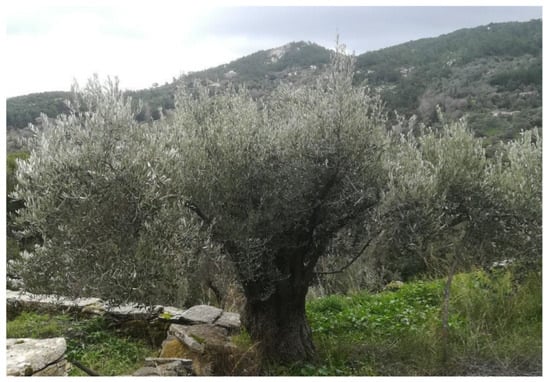
Figure 2.
Typical olive orchard in central Ikaria with old trees dominating the agricultural landscape (Photo: A. Pieroni).
Ikaria has been inhabited since at least 7000 BC when it was populated by the Neolithic Pelasgians (pre-Hellenic populations). Around 750 BC, Greeks from Miletus colonized Ikaria, establishing a settlement in the area of present-day Campos, which later became the ancient capital city of Oenoe. Despite the sparse population (around 8000), societal integrity has been a distinctive tract of the isle, and Ikarian Panegyris (traditional festivals featuring dance, music, and the consumption of local products), teamwork, and elder councils have possibly been the most resilient ones in all of Greece [16]. While poverty and migration have been a feature of the isle until the recent past, the quality of life improved greatly after 1960, when the Greek government began to invest in infrastructure to assist in the promotion of tourism, which today, however, remains much more limited than in most other Greek isles [16].
2.2. Ethnobotanical Field Study
The ethnobotanical fieldwork was conducted in January 2023 in the villages shown in Figure 1. The main purpose of the survey was to document local knowledge of wild leafy vegetables (Chorta) that are currently collected and consumed by local people.
Thirty-one study participants were interviewed through a combination of purposive sampling and snowball technique to participate in semi-structured interviews. We mainly targeted middle-aged and elderly people (range: 40 to 84 years), especially farmers, shepherds, and elderly women, since they are considered potential holders of local knowledge in the area. The number of study participants was fairly equal among all the eleven selected settlements. Prior to each interview, verbal informed consent was obtained from each study participant, and the Code of Ethics of the International Society of Ethnobiology [57] was rigorously followed. Semi-structured interviews were conducted in the local language (Greek) or English. We documented local name(s) and detailed food uses for each of the free-listed wild greens. We intentionally excluded mushrooms as well as wild fruits and snacks (i.e., wild plants mainly consumed for leisure outside food contexts or while walking in the wild) from the survey. The quoted wild food taxa were collected from the study area, when available, and identified by R. Kalle and N. Krigas using standard reference works on the Aegean flora [53,54,55,56]. Plant specimens (Figure 3) were collected whenever possible and voucher specimens (with numbers UVVETBOTIK01-38) were deposited at the Herbarium of the Bio-Cultural Diversity Lab of the Department of Environmental Sciences, Informatics and Statistics, Ca’ Foscari University of Venice, Italy. The identification of wild taxa, which were not available during the fieldwork, was conducted based on folk names and detailed descriptions of plant species (those botanical taxa do not bear voucher codes); in such cases, we showed photographs of the presumed plants to the study participants after a preliminary evaluation of the quoted local name and its description. Moreover, a comparison of local phytonyms was carried out with the records collected in our previous study conducted in Crete, in which we linked them to botanical vouchers and identities [58]. The World Flora Online database was followed for the nomenclature [59], while plant family names were consistent with the Angiosperm Phylogeny Website [60]. Recorded local Greek names were transcribed in the Latin alphabet directly from the phonetic transcriptions of the original recordings.
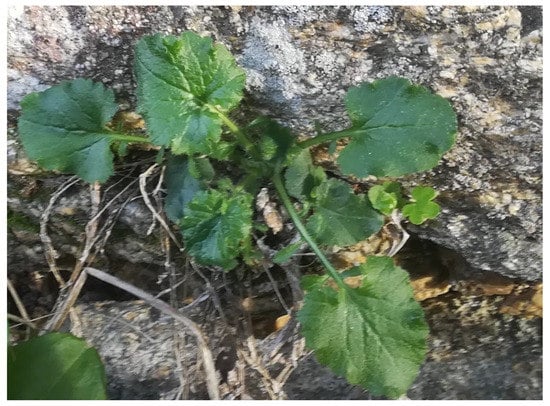
Figure 3.
Lapsana communis (Photo: A. Pieroni).
2.3. Cross-Cultural Data Analysis
A cross-cultural comparison was conducted by analyzing the data collected in the present study together with those reported by previous ethnobotanical studies on wild foods during the past decade in central/eastern Mediterranean and Near Eastern regions: coastal Syria (SYR), Lebanon (LEB), Palestine (PAL), Assyria (ASS), Kurdistan (KUR), Armenia (ARM), Crete (CRE), Sicily (SIC), and Tunisia (TUN) (Figure 4). We only considered field studies in which quotation indexes or at least clear indications about the most popular wild greens were reported. All considered studies focused on small communities (number of interviews between 20 and 50). In contrast, two studies (in Lebanon and Sicily) referred to large-scale surveys (151–980 informants) conducted over many years (2018–2022 and 2005–2015, respectively) [29,61]. Despite these discrepancies, we decided to include them because other suitable ethnobotanical investigations with quotation indexes were lacking in these two areas. Lastly, the results were also discussed with those reported in recent years among Assyrians in Iraqi Kurdistan and along the Syrian-Turkish border [62,63], since most researchers tend to agree with the theory of continuity between modern Assyrian people and ancient Assyrian people, i.e., Mesopotamian Neolithic farmers [64].
We deliberately avoided considering ethnobotanical works based on market surveys only, as they cannot reveal the actual domestic plant uses and their cultural salience within households, simple reviews on wild food plants, and ethnobotanical studies without clear evidence of genuine ethnographic and in-depth ethnobiological methods [65]. Moreover, in this analysis, we considered botanical genera and not botanical species or subspecies, as we wanted to mitigate the effect of possible differences in ecological occurrences of single species within the same genera in different areas.

Figure 4.
Central-eastern Mediterranean and Near Eastern field study areas used in the comparative analysis; letter codes refer to the considered sites reported in Table 1.

Table 1.
Details of the previous ethnobotanical field studies on traditional wild greens used for the comparative analysis (see Figure 4).
2.4. Statistical Analysis
For the cross-cultural comparison, a matrix was built in which the top quoted wild greens (WGs) genera were reported in rows, while the local use/non-use, as well as the sensory classification, were reported in columns. From a sensory point of view, plants were classified as ‘bitter/pungent’, ‘non-bitter’, or ‘aromatic’ (respectively: ‘pik’, ‘gly’, and ‘myr’ as shown in Table 2). In Ikaria and Crete, this classification was emic, i.e., based on interviews with respondents, depending on how they spontaneously described WGs, while for the other locations, the sensory classification was assigned on the basis of the botanical identity (etic perception).

Table 2.
Reported Ikarian wild greens and their local names, local culinary uses, reported perceived sensory classification, and frequency of quotation.
We used Pearson’s measure of correlation to calculate the correlation between the 10 study sites based on species use and non-use, as well as the sensory characterization. The Pearson correlation coefficient (rho), whose value ranges from −1 (perfect negative correlation) to +1 (perfect positive correlation), with 0 indicating no linear correlation, evaluates the degree and direction of the association between the study locations (see Figure 4). We performed the Pearson correlation analysis in Origin Pro software version 10. For comparing the relationships between the study sites and the use/non-use of WGs genera, we employed a detrended correspondence analysis (DCA), which is an ordination technique supported by reciprocal averaging. DCA is an eigenvector ordination technique used to detect the length of the gradient and the relationship among biological types [70]. In DCA, data are transformed to remove the linear trend, allowing the analysis to focus on the nonlinear relationships between the variables. This can be useful in identifying underlying patterns in complex data sets; DCA was performed in CANOCO version 4.5.
Multiple correspondence analysis (MCA) is a multivariate statistical method aimed at detecting groups of individuals with similar profiles, as well as the associations between several categorical variables. MCA generalizes simple correspondence analysis, which is limited to two categorical variables [71]. It also generalizes principal component analysis when the variables are categorical and not quantitative [72]. We applied MCA to the data in Table 3 to investigate the association among the sensory classification (ar, b, and nb) and considered areas (IKA, CRE, LEB, SYR, TUN, SIC, ARM, PAL, ASS, and KUR). We also used MCA to investigate the similarities/dissimilarities among units (wild greens). From a statistical perspective, the variable “sensory classification” is categorical, and the variable “areas” may be represented as several, and therefore as dichotomous, categorical variables (presence/absence of local food uses). We carried out the MCA in R software using the function MCA in the FactoMineR package [73,74]. For data visualization, we used the Factoextra package [75].

The biplot is the graphical output of MCA. The distance between any pair of row or column points provides a measure of their similarity (or dissimilarity). Row points with similar profiles are close to each other on the factor map. The same holds true for column points. The first two dimensions retain 46.5% of the total inertia (variation) contained in the data. The quality of the representation is called the squared cosine (cos2) and measures the degree of the association between variable categories and a particular axis. If a variable category is well represented by two dimensions, the sum of the corresponding cos2 is close to one.
3. Results and Discussion
3.1. Ikarian Chorta
The wild greens-based food heritage of central Ikaria includes fifty-six botanical taxa, of which fifty-five were identified (Table 2).
Most of the reported species were bitter Asteraceae (members of 14 genera) and pungent/bitter Brassicaceae (3 genera). Among other bitter compounds, edible Asteraceae contain sesquiterpenoids, which are considered to be chemosystematic markers of them [76,77], while Brassicaceae contain glucosinolates (bitter) and precursors of isothiocyanates (pungent), generally making these plants both bitter and pungent [78].
This picture is similar to the one reported one century ago by von Heldreich [48] in the first economic botanical survey conducted in Greece and in a more recent investigation we carried out in Crete [58], as well as in the other wild food ethnobotanical studies of the Mediterranean [17,18,19,20,21,22,23,24,25,26,27,28,29,30].
In Figure 5, we report the proportion of bitter/pungent Asteraceae and Brassicaceae in the overall Ikarian flora among the traditionally gathered Ikarian wild greens and the top quoted Ikarian wild greens.
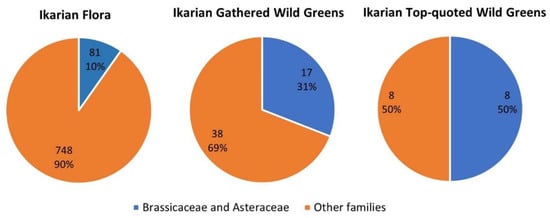
Figure 5.
Bitter/pungent Asteraceae and Brassicaceae species in the Ikarian flora and among the traditionally gathered Ikarian wild greens.
The disproportion between the ecological and cultural dimensions of these two botanical families is very clear. In fact, despite Asteraceae and Brassicaceae not being highly represented in the Ikarian flora, these families were among the most quoted. This shows that Ikarian inhabitants look predominately for bitter/pungent wild greens.
Bitter taste seems to have played an additional crucial role in shaping the cognition of wild greens. In the study area, all our participants described wild greens as Chorta; however, the cognitive categories underpinned in the folk classification of Chorta are linked to the perceived taste. Respondents showed remarkably high agreement in classifying plants as ‘bitter/pungent’, ‘non-bitter’, or ‘aromatic’ (Figure 6). The term ‘bitter’ technically refers to one of the so-called basic tastes [79], the detection of which is due to at least 25 receptors (members of the G-protein-coupled receptors superfamily) expressed in taste receptor cells in the oral cavity [80]. In contrast, the term ‘pungent’ refers to a chemesthetic sensation, precisely pungency, due to the activation of transient receptor potential ankyrin 1 (TRPA1), one of the about 30 TRPs identified in mammals [81]. Pungency is often also described as burning or oral irritation. The term ‘aromatic’ may refer to the volatile fraction, which is responsible for the sensation of smell through the activation of olfactory receptors in the olfactory bulb both ortho-nasally (e.g., when smelling food) and retro-nasally (e.g., when swallowing food) [82,83,84].
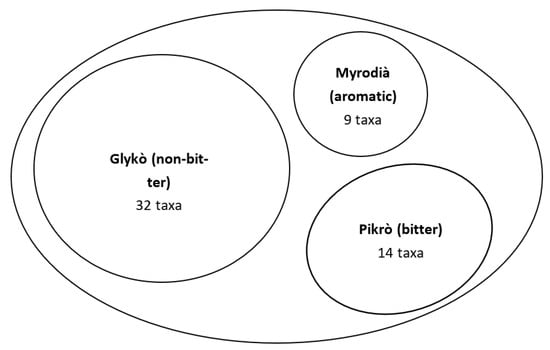
Figure 6.
Folk classification of wild greens (Chorta) according to their sensory classification as perceived among Ikarian people.
In Ikaria, most wild greens are consumed boiled (then seasoned with olive oil and lemon) (Figure 7) and in pies; preparations with eggs are also popular.
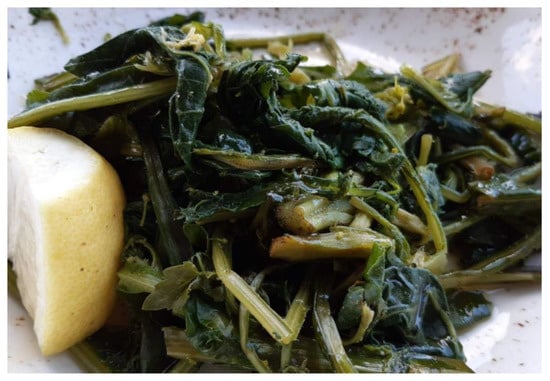
Figure 7.
Typical culinary preparation of local Chorta on Ikaria Island (Photo: A. Pieroni).
3.2. Cross-Cultural Comparisons
The cross-cultural comparison of the collected Ikarian data with those from other Mediterranean and Near Eastern sites was conducted by building a matrix (Table 3) in which only botanical genera that were recorded as very commonly quoted or used in the study sites were considered.
Comparisons between the collected Ikarian data with those from other Mediterranean and Near Eastern sites (referring to the use/non-use of the top quoted wild greens) are shown in Figure 8 and Figure 9. Ikarian wild greens show the highest similarity with the Cretan ones and, to a lesser extent, the Sicilian ones. Some similarities with the Syrian, Assyrian, and Lebanese data also emerged, while the highest dissimilarities were found between the Ikarian data and those from Armenia, Kurdistan, Palestine, and Tunisia.
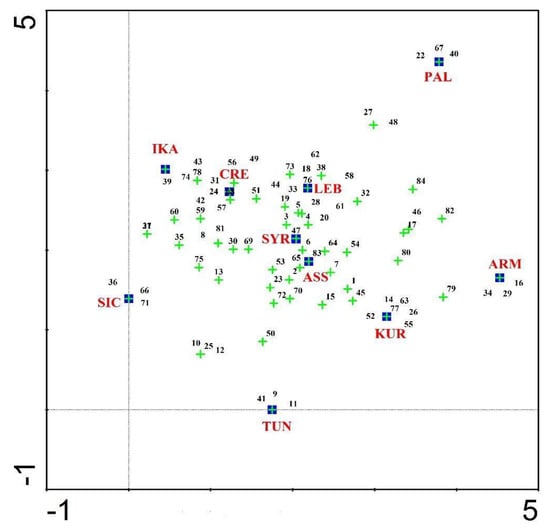
3.3. Bitter Is Better
When the comparative analysis was conducted considering the sensory classification, the overall picture described in the previous paragraph became clearer and somewhat surprising (Figure 10 and Figure 11). In the plot, we limit ourselves to mentioning that the sums of virtually all cos2 are greater than 0.80, and the best representations in two dimensions are given by the variables ar, b, and CRE; the corresponding cos2 are always greater than 0.70. Variable categories that contribute the most to the first two dimensions constitute the best summaries of the variability in the data set. They are ar (26.6%), CRE_1 (23.95%), ARM_1 (18.83%), b (16.11%), IKA_1 (14.27%), KUR_1 (13.67%), SIC_1 (12.65%), and SYR_1 (11.21%).
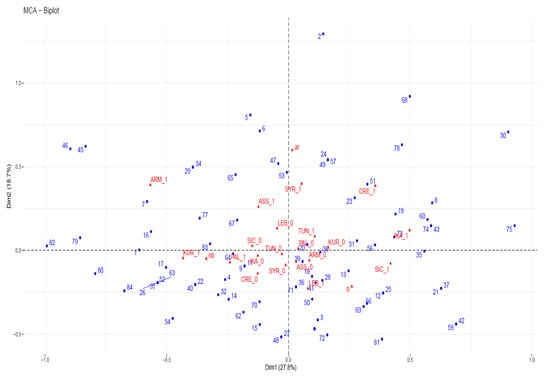
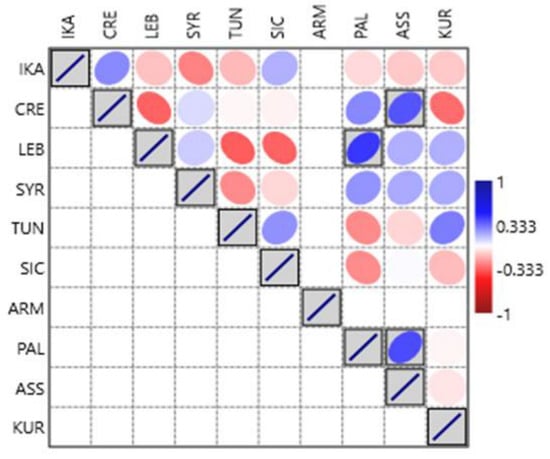
Figure 11.
Similarities of the wild greens in the considered sites (based on the matrix in Table 3) based on their tastes.
The comparison of the reported sensory description of Ikarian wild greens again shows major similarities to those of Sicily and Crete. There are a few considerations that appear from the data that are particularly relevant and complex: one concerning Armenians and another concerning Assyrians. The remarkable absence of top-quoted bitter wild greens among Armenians is interesting and can only be partially linked to the fact that Armenians have a higher proportion of PROP tasters [85] than other neighboring populations. So-called tasters are individuals that perceive the bitterness of the non-natural compounds PTC (phenylthiocarbamide) and PROP (6-n-propylthiouracil), both of which activate the bitter taste receptor T2R38, as highly intense. For this bitter taste receptor, two main alleles in populations worldwide are known [86]: the PTC taster PAV (encoding proline, alanine, and valine at the respective variant sites) and the PTC non-taster AVI (encoding alanine, valine, and isoleucine at these sites). T2R38 is also one of the bitter receptors activated by most glucosinolates and some isothiocyanates [78].
Certain studies reported that the bitterness of PROP positively correlates with the bitterness intensity of glucosinolates in broccoli juice [87] and that specific genotypes for gene T2R38 (PAV/PAV) are associated with an increased bitterness of glucosinolates-containing foods [88]. However, other studies did not find a relationship between PROP sensitivity and the intake of cruciferous vegetables when considering ethnically diverse children [89]. In fact, the perception of oral bitterness is complex, and the more than 25 receptors for bitter molecules in food have a complex tuning [90]. Moreover, plants belonging to different families (e.g., Asteraceae and Brassicaceae) contain different secondary metabolites activating different bitter receptors, and covariation in responsiveness to these compounds has been poorly documented so far, especially from a cross-cultural perspective.
The data found in the current research warrant further investigation in additional studies and in different directions. Even if it is true that the perception of bitterness (also including its genetic factors) has a role in food preferences, we know that learning plays a major part in what is identified as food, as we learn to like certain foods. In addition, humans learned that bitterness is a hallmark of bioactivity: we used this sensory property as a means to select non-cultivated plants with positive effects on health, with this benefit outweighing their initial unpleasantness. A similar process has been suggested as the driving force for positively selecting food characterized by hotness and pungency [91,92].
With regard to the MD, the fact that a “good” olive oil should be bitter and pungent represents an adequate tasty example: such attributes have long been traditionally used as quality markers, but this has only recently been demonstrated at a molecular level [93]. Moreover, recent studies have demonstrated that bitter and pungent phytochemicals have a higher probability of exerting anti-inflammatory effects than other secondary metabolites [94].
One of the directions to be explored to find a possible explanation for these differences lies with exercised culinary practices, as cuisine is not only a matter of ingredients, but ultimately how these ingredients are combined and treated. Moreover, such practices usually play a significant role in making the final preparation not only edible (consumable) for people (with their genetics) living in a certain place, but also pleasant for them (with their genetics and culture). Therefore, we have to look at local cuisines as bio-cultural processes able to incorporate experiences into procedures, resulting from a long sequence of cultural assimilation following body assimilation, with an observation of health effects being performed, not only in the short term (trial and error, acute toxicity) but also in the long term (well-being and health) [95]. In this sense, traditional cuisines and the concomitant diets they generate are the best longitudinal studies to which we can refer.
An example of the role that different culinary practices could have in the sensory acceptability of a wild plant comes from a study demonstrating how the perception of the bitter sesquiterpene lactones compounds in Asteraceae is different at different pH levels: it is enough to add lemon to a plant of this family to mitigate the bitterness of these compounds (also proven by in vitro tests) [76], making it more acceptable. However, in the intestine, the pH is different (less acidic), and, therefore, the activation of bitter receptors expressed there will be possible, with all the associated health benefits. It is worth noting that in Ikaria most of the boiled Chorta, including bitter ones, are consumed with lemon, and this is consistently perceived as a culinary “must” by elderly community members.
Apart from the Armenian data, an interesting link emerges between the Christian faith and the detected major preference for bitter greens (Figure 12). This may suggest that the tradition of fasting during Lent could have enhanced the popularity of wild greens foraging and consumption during the spring, as our study participants pointed out and as qualitative unpublished data gathered among mixed Muslim and Christian coastal Syrian communities have confirmed. It is known that in the Bible the term ‘bitter’ often appears. For example, in Exodus 12:8, Israelite families were called by God ‘to eat meat roasted over the fire, along with bitter herbs, and bread made without yeast’. So rather than a savory seasoning for meat, God’s call for bitter greens was meant to serve as a reminder of the bitter existence of Jews under the Pharaoh’s oppressive rule. In this sense, bitterness could be seen as a memory carrier of the sacrifices and in opposition to ostentation, which may have been adopted later by Christians. Other religious factors may have influenced the consumption of specific herbs by some Muslim communities in the Near East. Al-Hakim Bi Amr Allah, one ruler of the Fatimid Caliphate (an empire that ruled the southern and eastern Mediterranean between 909 and 1171 AD), prohibited the eating of molokhia (Corchorus olitorius L.) for religious symbolic reasons. This ban was subsequently followed by Ismaili and Druze communities for some time. For similar reasons, the consumption of Nasturtium officinale was not recommended/preferred [96].
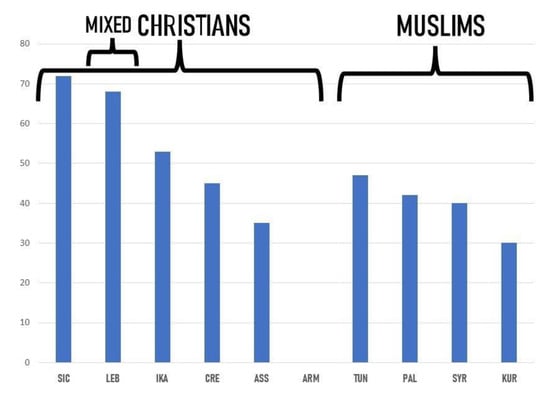
However, the fact that Christian Assyrians (descendants of the first Neolithic settlers) do not seem to particularly like bitter greens is surprising and needs further investigation. The Neolithic diet, which introduced bitter/pungent weeds into human nutrition, could have originated in the Fertile Crescent without necessarily privileging bitter greens at its inception. Instead, bitter wild greens could have become more crucial when Neolithic dietary systems, which moved westward across the Mediterranean basin a few thousand years BC, were influenced by Hebrew food perceptions and, later, by the spread of Christianity and its fasting prescriptions during Lent. In fact, early Christian communities strictly observed fasting as a common religious practice [97], which is believed to have originated from Jewish religious culture [98]. The practice of abstaining from certain foods or drinks, however, was already present in late antiquity [99], although it did not spread consistently [100]. In the modern age, the Catholic Church maintained fasting or tough dietary prescriptions until the 20th Century, such as on Fridays, Ash Wednesday, and during Lent [101]. Throughout the modern era [102], fasting during Lent has been challenged by Protestantism, but it has remained an essential practice in affirming the identity of Mediterranean Christian religious communities [103], especially in eastern Churches [101,104,105,106]. The dietary rules of Greek Orthodox Christianity have, in fact, significantly influenced the Greek Mediterranean diet [107].
3.4. How to Make Food Heritage of Wild Greens Trendy Again
The wild plant portion of Mediterranean diets is not only an important part of the local biological and cultural heritage, but also a significant driver of small-scale economies. A few of the recorded plants were available in local farmers’ markets, and in the study sites, they are on the menu of almost every taverna, where in the summer many tourists enjoy homemade Greek dishes of the MD. These incipient dynamics of valorization could open up promising opportunities to promote these key elements of the MD at a local level, which, to date, have been poorly considered and not valorized in the framework of institutional projects. Unlike other contexts where attempts to promote MD took place [108], the Ikarian scenario could follow a more bottom-up and participatory path towards the revitalization of this corpus of food and associated sociability. The resilience of the heritage of Chorta is remarkable in Ikaria, but the local knowledge and practices linked to these wild greens are mainly in the hands of elderly community members. It is therefore crucial to find tools and frameworks that can facilitate the transmission of this knowledge to newer generations.
Starting from the baseline data regarding the material and immaterial elements connected to the local foodscape and its gastronomy (i.e., ingredients, products, and dishes, as well as their production, preparation, and consumption methods) and the understanding of the continuous changes in these dietary systems, this process could develop around a strong involvement of local actors and the creation of inclusive platforms that also involve potential newcomers/external agents (e.g., social and cultural entrepreneurs and innovators).
Although most of the study participants agreed that young people no longer know about Chorta, we observed some young Ikarian farmers actively working to place sustainable local food, organic farming, and wild greens once again at the center of their lives. This may also be due to the socio-cultural context of Ikaria, which, from being one of the poorest islands of Greece after World War II, has increasingly, during the past two decades, turned into an important hub for many youngsters in Greece and southern Europe, who have wanted to reconnect to nature via social projects and reject mass tourism and capitalist consumerism. The sociability and food-sharing customs linked to Panegyris (traditional social gatherings and feasts, nowadays celebrating Saints’ name days and other religious Greek Orthodox Christian holidays) generate the iconic Ikarian cross-generational conviviality. The Ikarian social well-being acquired via this profound culture of commensality is possibly also one of the factors making the Ikarian diet so valuable, as discussed in other works [14,16,109], and a precious heritage itself. In Ikarian society, personal relations have a high value in general. According to Zouras [110], an 89-year-old woman described her relationship with neighbors in this way:
“They say here ‘your neighbor is your brother’ but sometimes your neighbor is more important because there is someone to go to if there’s an emergency…”.
Zouras [110] outlines five elements contributing to the higher socialization of vegetable gardening and foraging, and the presence of places supporting social interactions in common spaces deserve to be specifically stressed. Those spaces for meeting with the neighbors and other community members could serve for the future promotion of knowledge on wild vegetables, expressed in the form of informative installations and pre-planned meetings held by elders introducing wild greens and their uses to younger community members, followed by joint preparations in traditional and innovative ways. Creating a space for knowledge exchange in order to preserve a practice that is crucial from a health and food security perspective would be an important contribution from elderly community members, potentially motivating younger generations to explore and bring the traditional practice up to date. The survival and revitalization-in-practice of wild greens in Ikaria should pass through various ad hoc initiatives devoted to youngsters, both in terms of environmental and food education. Young people are increasingly conscious of environmental and health-related issues and may be more open to trying new foods if they find them beneficial to their well-being. Providing information about the ecological role and nutritional benefits of wild greens can contribute to increasing their consumption among young people. Local initiatives devoted to younger generations in the Mediterranean region could promote how to gather, clean, cook, and serve wild vegetables, making their inclusion in the daily diet easier. Indeed, it has been shown that cooking skills are positively correlated with vegetable consumption, healthier food choices, and increased adherence to nutritional guidelines [111].
To some extent, bitter foods and beverages are slowly re-gaining interest in the gastronomic panorama (i.e., beers characterized by a high level of bitterness, vermouth and related bitter wines and spirits, and chocolates with less sugar). Some well-known chefs are using bitter ingredients (many of which are foraged) to create more complex and unique dishes; therefore, bitterness has been the subject of some articles in magazines, such as the one in a recent issue of the magazine “The New York Times” [112]. Young foodies seem to have started to not dislike bitter food in principle: in a sample of healthy young people recruited among students at the University of Gastronomic Sciences (Bra, Italy), bitter-philic consumers outnumbered bitter-phobic ones (36.4% vs. 24.2%) [113].
4. Conclusions
This study recorded the wild greens-centered food and cultural heritage of central Ikaria, Greece. Most of the recorded species were frequently consumed during the spring, either boiled and seasoned with olive oil and lemon or prepared in savory pies. Cross-cultural/regional comparisons suggest that Ikarian Chorta customs have strong links to those of Crete and Sicily and may have evolved from an original “bulk” of weedy vegetables used by Neolithic farmers in the Near East, but from which the recorded heritage also shows significant differences. Possible cultural factors (culinary practices and religious prescriptions) underpinned in the observed commonalities and differences between Ikarian and other Mediterranean and Near East wild greens are considered and discussed as well.
The current research may provide a baseline that could contribute to a better understanding of the links between the wild plant portion of the MD, taste perception, and health in the Mediterranean and the Near East. Therefore, it constitutes the starting point for further studies to possibly identify the phytotastants in non-cultivated plants, the molecular structures with which they interact (receptors), and their variability between individuals in relation to health status. Future nutrition studies are strongly recommended to concern health-promoting properties associated with the consumption of wild green plants. Ultimately, fostering more research and evidence that “bitter is better”, both at the cultural and the molecular level, could inspire and strengthen programs aimed at promoting public awareness about the importance of bitter food heritage for improving health and well-being.
Author Contributions
Conceptualization: A.P., G.M., M.P. and R.S.; funding acquisition, methodology, and investigation: A.P. and R.S.; data curation: A.P., R.K. and N.K.; formal analysis: A.P., G.M., M.P., S.M.H., C.F. and R.S.; validation: A.P., L.T. and R.S.; project administration and writing—original draft: A.P.; writing—reviewing and editing: G.M., M.P., N.S., R.K., S.M.H., A.D., C.F., D.M.Z., R.M., J.P., M.S., N.K., M.A., L.T. and R.S. N.S. prepared the final version of the manuscript after incorporating all authors’ comments and edits, and he prepared the revised version after elaborating all reviewers’ comments. All authors have read and agreed to the published version of the manuscript.
Funding
This research was funded by the University of Gastronomic Sciences, Pollenzo, Italy, and by the Department of Environmental Sciences, Informatics and Statistics of the Ca’ Foscari University of Venice, Italy.
Institutional Review Board Statement
Not applicable.
Informed Consent Statement
The field study was conducted following the International Society of Ethnobiology (ISE) Code of Ethics, as clarified in the Methods section.
Data Availability Statement
All the data are provided in the article.
Acknowledgments
Special thanks are due to all study participants who generously shared their knowledge.
Conflicts of Interest
The authors declare that they have no conflict of interest.
References
- Keys, A. Seven Countries: A Multivariate Analysis of Death and Coronary Heart Disease; Harvard University Press: Cambridge, MA, USA, 1980. [Google Scholar]
- Davis, C.; Bryan, J.; Hodgson, J.; Murphy, K. Definition of the Mediterranean Diet: A Literature Review. Nutrients 2015, 7, 9139–9153. [Google Scholar] [CrossRef]
- Tosti, V.; Bertozzi, B.; Fontana, L. Health benefits of the Mediterranean diet: Metabolic and molecular mechanisms. J. Gerontol. Ser. A 2018, 73, 318–326. [Google Scholar] [CrossRef]
- Mentella, M.C.; Scaldaferri, F.; Ricci, C.; Gasbarrini, A.; Miggiano, G.A.D. Cancer and Mediterranean diet: A review. Nutrients 2019, 11, 2059. [Google Scholar] [CrossRef]
- Martínez-González, M.A.; Gea, A.; Ruiz-Canela, M. The Mediterranean diet and cardiovascular health: A critical review. Circ. Res. 2019, 124, 779–798. [Google Scholar] [CrossRef] [PubMed]
- Martín-Peláez, S.; Fito, M.; Castaner, O. Mediterranean diet effects on type 2 diabetes prevention, disease progression, and related mechanisms. A review. Nutrients 2020, 12, 2236. [Google Scholar] [CrossRef] [PubMed]
- UNESCO. Mediterranean Diet. Available online: https://ich.unesco.org/en/RL/mediterranean-diet-00884 (accessed on 18 March 2023).
- Serra-Majem, L.; Medina, F.X. The Mediterranean Diet as an Intangible and Sustainable Food Culture. In The Mediterranean Diet: An Evidence-Based Approach; Preedy, V.R., Watson, R.R., Eds.; University of Arizona: Tucson, AZ, USA, 2015; pp. 37–46. [Google Scholar]
- Naska, A.; Trichopoulou, A. Back to the future: The Mediterranean diet paradigm. Nutr. Metab. Cardiovasc. Dis. 2020, 24, 216–219. [Google Scholar] [CrossRef] [PubMed]
- Diolintzi, A.; Panagiotakos, D.B.; Sidossis, L.S. From Mediterranean diet to Mediterranean lifestyle: A narrative review. Public Health Nutr. 2019, 22, 2703–2713. [Google Scholar] [CrossRef]
- Bach-Faig, A.; Berry, E.M.; Lairon, D.; Reguant, J.; Trichopoulou, A.; Dernini, S.; Medina, F.X.; Battino, M.; Belahsen, R.; Miranda, G.; et al. Mediterranean diet pyramid today. Science and cultural updates. Public Health Nutr. 2011, 14, 2274–2284. [Google Scholar] [CrossRef]
- Obeid, C.A.; Gubbels, J.S.; Jaalouk, D.; Kremers, S.P.; Oenema, A. Adherence to the Mediterranean diet among adults in Mediterranean countries: A systematic literature review. Eur. J. Nutr. 2022, 61, 3327–3344. [Google Scholar] [CrossRef]
- D’Innocenzo, S.; Biagi, C.; Lanari, M. Obesity and the Mediterranean Diet: A Review of Evidence of the Role and Sustainability of the Mediterranean Diet. Nutrients 2019, 11, 1306. [Google Scholar] [CrossRef]
- Buettner, D.; Skemp, S. Blue Zones: Lessons from the World’s Longest Lived. Am. J. Lifestyle Med. 2016, 10, 318–321. [Google Scholar] [CrossRef] [PubMed]
- Nieddu, A.; Vindas, L.; Errigo, A.; Vindas, J.; Pes, G.M.; Dore, M.P. Dietary Habits, Anthropometric Features and Daily Performance in Two Independent Long-Lived Populations from Nicoya peninsula (Costa Rica) and Ogliastra (Sardinia). Nutrients 2020, 12, 1621. [Google Scholar] [CrossRef] [PubMed]
- Pes, G.M.; Dore, M.P.; Tsofliou, F.; Poulain, M. Diet and longevity in the Blue Zones: A set-and-forget issue? Maturitas 2022, 164, 31–37. [Google Scholar] [CrossRef]
- Biscotti, N.; Pieroni, A. The hidden Mediterranean diet: Wild greens traditionally gathered and consumed in the Gargano area, Apulia, SE Italy. Acta Soc. Bot. Pol. 2015, 84, 327–338. [Google Scholar] [CrossRef]
- Łuczaj, Ł.; Zovkokoncic, M.; Milicevic, T.; Dolina, K.; Pandza, M. Wild vegetable mixes sold in the markets of Dalmatia (southern Croatia). J. Ethnobiol. Ethnomed. 2013, 9, 2. [Google Scholar] [CrossRef]
- Łuczaj, Ł.; Dolina, K. A hundred years of change in wild vegetable use in southern Herzegovina. J. Ethnopharmacol. 2015, 166, 297–304. [Google Scholar] [CrossRef]
- Dolina, K.; Łuczaj, Ł. Wild food plants used on the Dubrovnik coast (south-eastern Croatia). Acta Soc. Bot. Pol. 2014, 83, 175–181. [Google Scholar] [CrossRef]
- Dogan, Y. Traditionally used wild edible greens in the Aegean Region of Turkey. Acta Soc. Bot. Pol. 2012, 81, 329–341. [Google Scholar] [CrossRef]
- Dogan, Y.; Ugulu, I.; Durkan, N. Wild edible plants sold in the local markets of Izmir, Turkey. Pak. J. Bot. 2013, 45, 177–184. [Google Scholar]
- Ertuğ, F. Wild edible plants of the Bodrum area (Mula, Turkey). Turk. J. Bot. 2004, 28, 161–174. [Google Scholar]
- Della, A.; Paraskeva-Hadjichambi, D.; Hadjichambis, A. An ethnobotanical survey of wild edible plants of Paphos and Larnaca countryside of Cyprus. J. Ethnobiol. Ethnomed. 2006, 2, 34. [Google Scholar] [CrossRef] [PubMed]
- Hadjichambis, A.; Paraskeva-Hadjichambi, D.; Della, A.; Giusti, M.E.; de Pasquale, C.; Lenzarini, C.; Censorii, E.; Reyes Gonzales-Tejero, M.; Patricia Sanchez-Rojas, C.; Ramiro-Gutierrez, J.M.; et al. Wild and semi-domesticated food plant consumption in seven circum-Mediterranean areas. Int. J. Food Sci. Nutr. 2008, 59, 383–414. [Google Scholar] [CrossRef] [PubMed]
- Leonti, M.; Nebel, S.; Rivera, D.; Heinrich, M. Wild gathered food plants in the European Mediterranean: A comparative analysis. Econ. Bot. 2006, 60, 130–142. [Google Scholar] [CrossRef]
- Pieroni, A.; Nebel, S.; Santoro, R.F.; Heinrich, M. Food for two seasons: Culinary uses of non-cultivated local vegetables and mushrooms in a south Italian village. Int. J. Food Sci. Nutr. 2005, 56, 245–272. [Google Scholar] [CrossRef] [PubMed]
- Nebel, S.; Pieroni, A.; Heinrich, M. Ta chorta: Wild edible greens used in the Graecanic area in Calabria, southern Italy. Appetite 2006, 47, 333–342. [Google Scholar] [CrossRef]
- Geraci, A.; Amato, F.; Di Noto, G.; Bazan, G.; Schicchi, R. The wild taxa utilized as vegetables in Sicily (Italy): A traditional component of the Mediterranean diet. J. Ethnobiol. Ethnomed. 2018, 14, 14. [Google Scholar] [CrossRef]
- Pieroni, A.; Cattero, V. Wild greens do not lie: Comparative gastronomic ethnobotany and ethnolinguistics on the Greek traces of the Mediterranean Diet of southeastern Italy. Acta Bot. Bras. 2019, 33, 198–211. [Google Scholar] [CrossRef]
- Motti, R.; Bonanomi, G.; Lanzotti, V.; Sacchi, R. The contribution of wild edible plants to the Mediterranean Diet: An ethnobotanical case study along the coast of Campania (Southern Italy). Econ. Bot. 2020, 74, 249–272. [Google Scholar] [CrossRef]
- Pieroni, A.; Nebel, S.; Quave, C.L.; Münz, H.; Heinrich, M. Ethnopharmacology of liakra, traditional weedy vegetables of the Arbëreshë of the Vulture area in southern Italy. J. Ethnopharmacol. 2002, 81, 165–185. [Google Scholar] [CrossRef]
- Cucinotta, F.; Pieroni, A. “If you want to get married, you have to collect virdura”: The vanishing custom of gathering and cooking wild food plants on Vulcano, Aeolian Islands, Sicily. Food Cult. Soc. 2018, 31, 539–567. [Google Scholar] [CrossRef]
- Local Food-Nutraceuticals Consortium. Local Food-Nutraceuticals Consortium. Understanding local Mediterranean diets: A multidisciplinary pharmacological and ethnobotanical approach. Pharmacol. Res. 2005, 52, 353–366. [Google Scholar] [CrossRef]
- Chatzopoulou, E.; Carocho, M.; Di Gioia, F.; Petropoulos, S.A. The beneficial health effects of vegetables and wild edible greens: The case of the Mediterranean Diet and its sustainability. Appl. Sci. 2020, 10, 24. [Google Scholar] [CrossRef]
- García-Herrera, P.; Morales, P.; Cámara, M.; Fernández-Ruiz, V.; Tardío, J.; Sánchez-Mata, M.C. Nutritional and phytochemical composition of Mediterranean wild greens after culinary treatment. Foods 2020, 9, 1761. [Google Scholar] [CrossRef]
- Leonti, M. The co-evolutionary perspective of the food-medicine continuum and wild gathered and cultivated vegetables. Gen. Res. Crop Evol. 2012, 59, 1295–1302. [Google Scholar] [CrossRef]
- Stepp, R.J.; Moerman, D.E. The importance of weeds in Ethnopharmacology. J. Ethnopharmacol. 2001, 75, 19–23. [Google Scholar] [CrossRef]
- Finger, T.E.; Kinnamon, S.C. Taste isn’t just for taste buds anymore. F1000 Biol. Rep. 2011, 3, 20. [Google Scholar] [CrossRef]
- Harmon, C.P.; Deng, D.; Breslin, P.A. Bitter taste receptors (T2Rs) are sentinels that coordinate metabolic and immunological defense responses. Curr. Opin. Physiol. 2021, 20, 70–76. [Google Scholar] [CrossRef]
- Cui, M.; Chen, B.; Xu, K.; Rigakou, A.; Diamantakos, P.; Melliou, E.; Logothetis, D.E.; Magiatis, P. Activation of specific bitter taste receptors by olive oil phenolics and secoiridoids. Sci. Rep. 2021, 11, 22340. [Google Scholar] [CrossRef]
- Des Gachons, C.P.; Uchida, K.; Bryant, B.; Shima, A.; Sperry, J.B.; Dankulich-Nagrudny, L.; Tominaga, M.; Smith, A.B.; Beauchamp, G.K.; Breslin, P.A. Unusual pungency from extra-virgin olive oil is attributable to restricted spatial expression of the receptor of oleocanthal. J. Neurosci. 2011, 31, 999–1009. [Google Scholar] [CrossRef]
- Crespo, M.C.; Tomé-Carneiro, J.; Dávalos, A.; Visioli, F. Pharma-nutritional properties of olive oil phenols. Transfer of new findings to human nutrition. Foods 2018, 7, 90. [Google Scholar] [CrossRef]
- Beauchamp, G.K.; Keast, R.S.; Morel, D.; Lin, J.; Pika, J.; Han, Q.; Lee, C.; Smith, A.B.; Breslin, P.A. Ibuprofen-like activity in extra-virgin olive oil. Nature 2005, 437, 45–46. [Google Scholar] [CrossRef]
- Torri, L.; Bondioli, P.; Folegatti, L.; Rovellini, P.; Piochi, M.; Morini, G. Development of Perilla seed oil and extra virgin olive oil blends for nutritional, oxidative stability and consumer acceptance improvements. Food Chem. 2019, 286, 584–591. [Google Scholar] [CrossRef]
- Tuorila, H.; Recchia, A. Sensory perception and other factors affecting consumer choice of olive oil. In Olive Oil Sensory Science; Monteleone, E., Langstaff, S., Eds.; Wiley: Hoboken, NJ, USA, 2014; pp. 55–80. [Google Scholar]
- Roura, E.; Aldayyani, A.; Thavaraj, P.; Prakash, S.; Greenway, D.; Thomas, W.G.; Meyerhof, W.; Roudnitzky, N.; Foster, S.R. Variability in human bitter taste sensitivity to chemically diverse compounds can be accounted for by differential TAS2R activation. Chem. Senses 2015, 40, 427–435. [Google Scholar] [CrossRef]
- von Heldreich, T. Die Nutzpflanzen Griechenlands mit Besonderer Berücksichtigung der Neugriechischen und Pelasgischen Vulgarnamen; Karl Vilberg: Athens, Greece, 1862. [Google Scholar]
- Sordinas, A. Wild plant for subsistence on the Island of Corfu, Greece. In Proceedings of the 70th Annual Meeting of the American Anthropological Association, New York, NY, USA, 30 November 1971. [Google Scholar]
- Psaroudaki, A.; Dimitropoulakis, P.; Constantinidis, T.; Katsiotis, A.; Skaracis, G.N. Ten indigenous edible plants: Contemporary use in Eastern Crete, Greece. Cult. Agric. Food Env. 2012, 34, 172–177. [Google Scholar] [CrossRef]
- Stavridakis, K.G. Wild Edible Plants of Crete; K.G. Stavridakis: Rethymno, Greece, 2006. [Google Scholar]
- Kochilas, D. Ikaria. Lessons on Food, Life, and Longevity from the Greek Island Where Peoples Forget to Die; Rodale: New York, NY, USA, 2014. [Google Scholar]
- Rechinger, K.H. Flora Aegaea: Flora d. Inseln u. Halbinseln d. aegaeischen Meeres; Springer: Vienna, Austria, 1944. [Google Scholar]
- Strid, A. Atlas of the Aegean Flora; Botanic Garden and Botanical Museum Berlin, Freie Universität Berlin: Berlin, Germany, 2016. [Google Scholar] [CrossRef]
- Turland, N.J.; Chilton, L.; Press, J.R. Flora of the Cretan Area. Annotated Checklist & Atlas; HMSO: London, UK, 1995. [Google Scholar]
- Dimopoulos, P.; Raus, T.; Bergmeier, E.; Constantinidis, T.; Iatrou, G.; Kokkini, S.; Strid, A.; Tzanoudakis, D. Vascular Plants of Greece: An Annotated Checklist (and Its Supplement); Botanic Garden and Botanical Museum Berlin-Dahlem: Berlin, Germany; The Hellenic Botanical Society: Athens, Greece, 2013. [Google Scholar]
- Internationals Society of Ethnobiology. Code of Ethics. 2006. Available online: https://www.ethnobiology.net/what-we-do/core-programs/ise-ethics-program/code-of-ethics/ (accessed on 10 May 2023).
- Pieroni, A.; Sulaiman, N.; Sõukand, R. Chorta (Wild Greens) in Central Crete: The Bio-Cultural Heritage of a Hidden and Resilient Ingredient of the Mediterranean Diet. Biology 2022, 11, 673. [Google Scholar] [CrossRef]
- The World Flora Online. Available online: http://www.worldfloraonline.org/ (accessed on 18 March 2023).
- Stevens, P.F.; Angiosperm Phylogeny Website. Version 14. Available online: http://www.mobot.org/MOBOT/research/APweb/ (accessed on 18 March 2023).
- Baydoun, S.; Hani, N.; Nasser, H.; Ulian, T.; Arnold-Apostolides, N. Wild leafy vegetables: A potential source for a traditional Mediterranean food from Lebanon. Front. Sustain. Food Syst. 2023, 6, 991979. [Google Scholar] [CrossRef]
- Pieroni, A.; Sõukand, R.; Amin, H.I.M.; Zahir, H.; Kukk, T. Celebrating multi-religious co-existence in central Kurdistan: The bio-culturally diverse traditional gathering of wild greens among Yazidis, Assyrians, and Muslim Kurds. Hum. Ecol. 2018, 46, 217–227. [Google Scholar] [CrossRef]
- Abdalla, M. Wild growing plants in the cuisine of modern Assyrians in the Eastern Syrian-Turkish borderland. J. Assyrian Acad. Stu. 2004, 18, 50–58. [Google Scholar]
- Frahm, E. (Ed.) A Companion to Assyria; John Wiley & Sons: Hoboken, NJ, USA, 2019. [Google Scholar]
- Berlin, B. Ethnobiological Classification: Principles of Categorization of Plants and Animals in Traditional Societies; Princeton University Press: Princeton, NJ, USA, 2014; Volume 185. [Google Scholar]
- Dop, M.C.; Kefi, F.; Karous, O.; Verger, E.O.; Bahrini, A.; Ghrabi, Z.; El Ati, J.; Kennedy, G.; Termote, C. MEDINA Study Group. Identification and frequency of consumption of wild edible plants over a year in central Tunisia: A mixed-methods approach. Public Health Nutr. 2020, 23, 782–794. [Google Scholar] [CrossRef]
- Sulaiman, N.; Pieroni, A.; Sõukand, R.; Polesny, Z. Food behavior in emergency time: Wild plant use for human nutrition during the conflict in Syria. Foods 2022, 11, 177. [Google Scholar] [CrossRef]
- Ali-Shtayeh, M.S.; Jamous, R.M.; Al-Shafie’, J.H.; Elgharabah, W.A.; Kherfan, F.A.; Qarariah, K.H.; Khdair, I.S.; Soos, I.M.; Musleh, A.A.; Isa, B.A.; et al. Traditional knowledge of wild edible plants used in Palestine (Northern West Bank): A comparative study. J. Ethnobiol. Ethnomed. 2008, 4, 13. [Google Scholar] [CrossRef]
- Pieroni, A.; Hovsepyan, R.; Manduzai, A.K.; Sõukand, R. Wild food plants traditionally gathered in central Armenia: Archaic ingredients or future sustainable foods? Environ. Dev. Sustain. 2021, 23, 2358–2381. [Google Scholar] [CrossRef]
- Ter Braak, C.J. Canonical correspondence analysis: A new eigenvector technique for multivariate direct gradient analysis. Ecology 1986, 67, 1167–1179. [Google Scholar] [CrossRef]
- Izenman, A.J. Modern Multivariate Statistical Techniques. Regression, Classification, and Manifold Learning; Springer: Berlin/Heidelberg, Germany, 2008. [Google Scholar]
- Abdi, H.; Lynne, J.W. Principal Component Analysis. Wiley Interdiscip. Rev. Comput. Stat. 2010, 2, 433–459. [Google Scholar] [CrossRef]
- R Core Team. R: A Language and Environment for Statistical Computing; R Foundation for Statistical Computing: Vienna, Austria, 2021; Available online: https://www.R-project.org/ (accessed on 28 May 2023).
- Sebastien, L.; Josse, J.; Husson, F. FactoMineR: An R Package for Multivariate Analysis. J. Stat. Softw. 2008, 25, 1–18. [Google Scholar] [CrossRef]
- Alboukadel, K.; Mundt, F. factoextra: Extract and Visualize the Results of Multivariate Data Analyses. R Package Version 1.0.7. 2020. Available online: https://CRAN.R-project.org/package=factoextra (accessed on 20 May 2023).
- Yanagisawa, T.; Misaka, T. Characterization of the Human Bitter Taste Receptor Response to Sesquiterpene Lactones from Edible Asteraceae Species and Suppression of Bitterness through pH Control. ACS Omega 2021, 6, 4401–4407. [Google Scholar] [CrossRef]
- Zidorn, C. Sesquiterpene lactones and their precursors as chemosystematic markers in the tribe Cichorieae of the Asteraceae. Phytochemistry 2008, 69, 2270–2296. [Google Scholar] [CrossRef]
- Bell, L.; Oloyede, O.O.; Lignou, S.; Wagstaff, C.; Methven, L. Taste and flavor perceptions of glucosinolates, isothiocyanates, and related compounds. Mol. Nutr. Food Res. 2018, 62, 1700990. [Google Scholar] [CrossRef]
- Beauchamp, G.K. Basic Taste: A Perceptual Concept. J. Agric. Food Chem. 2019, 67, 13860–13869. [Google Scholar] [CrossRef]
- Behrens, M.; Meyerhof, W. Vertebrate bitter taste receptors: Keys for survival in changing environments. J. Agric. Food Chem. 2016, 66, 2204–2213. [Google Scholar] [CrossRef]
- Green, B.G. Chemesthesis: Pungency as a component of flavor. Trends Food Sci. Technol. 1996, 71, 415–420. [Google Scholar] [CrossRef]
- Blankenship, M.L.; Grigorova, M.; Katz, D.B.; Maier, J.X. Retronasal Odor Perception Requires Taste Cortex, but Orthonasal Does Not. Curr. Biol. 2019, 29, 62–69.e3. [Google Scholar] [CrossRef]
- Lawless, H. The sense of smell in food quality and sensory evaluation. J. Food Qual. 1991, 14, 33–60. [Google Scholar] [CrossRef]
- Shepherd, G.M. Smell images and the flavour system in the human brain. Nature 2006, 444, 316–321. [Google Scholar] [CrossRef]
- Robino, A.; Mezzavilla, M.; Pirastu, N.; Dognini, M.; Tepper, B.J.; Gasparini, P. A population-based approach to study the impact of PROP perception on food liking in populations along the Silk Road. PLoS ONE 2014, 9, e91716. [Google Scholar] [CrossRef]
- Risso, D.S.; Mezzavilla, M.; Pagani, L.; Robino, A.; Morini, G.; Tofanelli, S.; Carrai, M.; Campa, D.; Barale, R.; Caradonna, F.; et al. Global diversity in the TAS2R38 bitter taste receptor: Revisiting a classic evolutionary PROPosal. Sci. Rep. 2016, 6, 25506. [Google Scholar] [CrossRef]
- Lipchock, S.V.; Mennella, J.A.; Spielman, A.I.; Reed, D.R. Human bitter perception correlates with bitter receptor messenger RNA expression in taste cells. Am. J. Clin. Nutr. 2013, 98, 1136–1143. [Google Scholar] [CrossRef]
- Sandell, M.A.; Breslin, P.A.S. Variability in a gene determines whether we taste toxins in food. Curr. Biol. 2006, 16, 792–794. [Google Scholar] [CrossRef]
- Baranowski, T.; Baranowski, J.C.; Watson, K.B.; Jago, R.; Islam, N.; Beltran, A.; Martin, S.J.; Nguyen, N.; Tepper, B.J. 6-n-Propylthiouracil taster status not related to reported cruciferous vegetable intake among ethnically diverse children. Nutr. Res. 2011, 31, 594–600. [Google Scholar] [CrossRef]
- Bayer, S.; Mayer, A.I.; Borgonovo, G.; Morini, G.; Di Pizio, A.; Bassoli, A. Chemoinformatics View on Bitter Taste Receptor Agonists in Food. J. Agric. Food Chem. 2021, 69, 13916–13924. [Google Scholar] [CrossRef]
- Sherman, P.W.; Billing, J. Darwinian gastronomy: Why we use spices: Spices taste good because they are good for us. BioScience 1999, 49, 453–463. [Google Scholar] [CrossRef]
- Nilius, B.; Appendino, G. Tasty and healthy TR (i) Ps: The human quest for culinary pungency. EMBO Rep. 2011, 12, 1094–1101. [Google Scholar] [CrossRef]
- Vitaglione, P.; Savarese, M.; Paduano, A.; Scalfi, L.; Fogliano, V.; Sacchi, R. Healthy virgin olive oil: A matter of bitterness. Crit. Rev. Food Sci. Nutr. 2015, 55, 1808–1818. [Google Scholar] [CrossRef] [PubMed]
- Dragoș, D.; Petran, M.; Gradinaru, T.-C.; Gilca, M. Phytochemicals and Inflammation: Is Bitter Better? Plants 2022, 11, 2991. [Google Scholar] [CrossRef] [PubMed]
- Morini, G.; Luiselli, D.; Risso, D.S.; Tofanelli, S. Il gusto degli Italiani. In La Cultura del Cibo; UTET Grandi Opere: Torino, Italy, 2015; pp. 365–375. [Google Scholar]
- Saleh, H.M. The Civilization of Egypt in the Shadow of Shiite Islam; Dar Al-Juman: Beirut, Lebanon, 2003. [Google Scholar]
- Walker, B. This Kind Only Comes Out by Prayer (and Fasting): Fasting, Ritual Efficacy and Magical Thinking in Early Christianity. J. Ritual Stud. 2017, 31, 43–52. [Google Scholar]
- Mentzer, R.A. Fasting, Piety, and Political Anxiety among French Reformed Protestants. Church Hist. 2007, 76, 330–362. [Google Scholar] [CrossRef]
- Musurillo, H. The Problem of Ascetical Fasting in the Greek Patristic Writers. Traditio 1956, 12, 1–64. [Google Scholar] [CrossRef]
- Arbesmann, R. Fasting and Prophecy in Pagan and Christian Antiquity. Traditio 1951, 7, 1–71. [Google Scholar] [CrossRef]
- Barnett, E. Reforming Food and Eating in Protestant England, c. 1560–c. 1640. Hist. J. 2020, 63, 507–527. [Google Scholar] [CrossRef]
- Watts, S. Enlightened Fasting: Religious Conviction, Scientific Inquiry, and Medical Knowledge in Early Modern France. In Food and Faith in Christian Culture; Albala, K., Eden, T., Eds.; Columbia University Press: New York, NY, USA, 2011; pp. 105–124. [Google Scholar]
- Dumanowski, J. Old Polish Fasting: Discourse and Dietary Practices in the 16th–18th Century. In Gruppenidentitäten in Ostmitteleuropa; Dybaś, B., Bojarski, J., Eds.; V & R Unipress: Göttingen, Germany, 2021; pp. 93–116. [Google Scholar]
- Klymenko, I. The Fasting of Others: Constructing Interreligious Boundaries Through Bodily Practices in Christian Discourses Around 1600. Hist. Stud. Cent. Eur. 2022, 2, 60–75. [Google Scholar] [CrossRef]
- Heyberger, B. Fasting: The Limits of Catholic Confessionalization in Eastern Christianity in the Eighteenth Century, in Scholarship between Europe and the Levant; Loop, J., Kraye, J., Eds.; Brill: Leiden, The Netherlands, 2020; pp. 217–235. [Google Scholar] [CrossRef]
- Ivanov, A.V. A Spiritual Revolution: The Impact of Reformation and Enlightenment in Orthodox Russia, 1700–1825; University of Wisconsin Press: Madison, WI, USA, 2020. [Google Scholar]
- Sarri, K.; Linardakis, M.; Bervanaki, F.; Tzanakis, N.; Kafatos, A. Greek Orthodox fasting rituals: A hidden characteristic of the Mediterranean diet of Crete. Br. J. Nutr. 2004, 92, 277–284. [Google Scholar] [CrossRef]
- Pfeilstetter, R. Heritage entrepreneurship. Agency-driven promotion of the Mediterranean diet in Spain. Int. J. Herit. Stud. 2015, 21, 215–231. [Google Scholar] [CrossRef]
- Legrand, R.; Nuemi, G.; Poulain, M.; Manckoundia, P. Description of Lifestyle, Including Social Life, Diet and Physical Activity, of People ≥90 years Living in Ikaria, a Longevity Blue Zone. Int. J. Environ. Res. Public Health 2021, 18, 6602. [Google Scholar] [CrossRef]
- Zouras, E. Belonging as a concept in placemaking: Exploring perceptions in Ikaria, Greece: A study of belonging in the elderly in the Greek Blue Zone of Ikaria. Master’s Thesis, KTH Royal Institute of Technology, Stockholm, Sweden, 2020. Available online: https://www.diva-portal.org/smash/get/diva2:1592906/FULLTEXT01.pdf (accessed on 28 May 2023).
- Hartmann, C.; Dohle, S.; Siegrist, M. Importance of cooking skills for balanced food choices. Appetite 2013, 65, 125–131. [Google Scholar] [CrossRef]
- Goldfield, H. The Sweet Rewards of Bitter Food. The New York Times Magazine, 22 November 2017. Available online: https://www.nytimes.com/2017/11/22/t-magazine/bitter-food.html (accessed on 12 June 2023).
- Caremoli, F.; Bassoli, A.; Borgonovo, G.; Morini, G.; Torri, L. Do you like it bitter? A preliminary study on food preferences for bitter taste in a young population. In World Food Trends and the Future of Food; Nobile, M., Ed.; Ledizioni: Milano, Italy, 2015; pp. 75–94. [Google Scholar]
Disclaimer/Publisher’s Note: The statements, opinions and data contained in all publications are solely those of the individual author(s) and contributor(s) and not of MDPI and/or the editor(s). MDPI and/or the editor(s) disclaim responsibility for any injury to people or property resulting from any ideas, methods, instructions or products referred to in the content. |
© 2023 by the authors. Licensee MDPI, Basel, Switzerland. This article is an open access article distributed under the terms and conditions of the Creative Commons Attribution (CC BY) license (https://creativecommons.org/licenses/by/4.0/).
